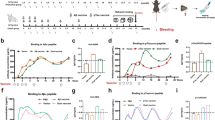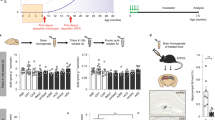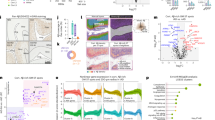Abstract
Amyloid-β peptide (Aβ) has a key role in the pathogenesis of Alzheimer disease (AD). Immunization with Aβ in a transgenic mouse model of AD reduces both age-related accumulation of Aβ in the brain1 and associated cognitive impairment2,3. Here we present the first analysis of human neuropathology after immunization with Aβ (AN-1792). Comparison with unimmunized cases of AD (n = 7) revealed the following unusual features in the immunized case, despite diagnostic neuropathological features of AD: (i) there were extensive areas of neocortex with very few Aβ plaques; (ii) those areas of cortex that were devoid of Aβ plaques contained densities of tangles, neuropil threads and cerebral amyloid angiopathy (CAA) similar to unimmunized AD, but lacked plaque-associated dystrophic neurites and astrocyte clusters; (iii) in some regions devoid of plaques, Aβ-immunoreactivity was associated with microglia; (iv) T-lymphocyte meningoencephalitis was present; and (v) cerebral white matter showed infiltration by macrophages. Findings (i)–(iii) strongly resemble the changes seen after Aβ immunotherapy in mouse models of AD1,2,3,4,5,6 and suggest that the immune response generated against the peptide elicited clearance of Aβ plaques in this patient. The T-lymphocyte meningoencephalitis is likely to correspond to the side effect seen in some other patients who received AN-1792 (refs. 7–9).
This is a preview of subscription content, access via your institution
Access options
Subscribe to this journal
Receive 12 print issues and online access
$209.00 per year
only $17.42 per issue
Buy this article
- Purchase on SpringerLink
- Instant access to full article PDF
Prices may be subject to local taxes which are calculated during checkout



Similar content being viewed by others
References
Schenk, D. et al. Immunization with amyloid-β attenuates Alzheimer-disease-like pathology in the PDAPP mouse. Nature 400, 173–177 (1999).
Janus, C. et al. Aβ peptide immunization reduces behavioural impairment and plaques in a model of Alzheimer's disease. Nature 408, 979–982 (2000).
Morgan, D. et al. β peptide vaccination prevents memory loss in an animal model of Alzheimer's disease. Nature 408, 982–985 (2000).
Bacskai, B.J. et al. Imaging of amyloid-β deposits in brains of living mice permits direct observation of clearance of plaques with immunotherapy. Nat. Med. 7, 369–372 (2001).
Bard, F. et al. Peripherally administered antibodies against amyloid β-peptide enter the central nervous system and reduce pathology in a mouse model of Alzheimer disease. Nat. Med. 6, 916–919 (2000).
Sigurdsson, E.M., Scholtzova, H., Mehta, P.D., Frangione, B. & Wisniewski, T. Immunization with a non-toxic/nonfibrillar amyloid-β homologous peptide reduces Alzheimer's disease-associated pathology in transgenic mice. Am. J. Pathol. 159, 439–447 (2001).
Birmingham, K. & Frantz, S. Set back to Alzheimer vaccine studies. Nat. Med. 8, 199–200 (2002).
Bishop, G.M., Robinson, S.R., Smith, M.A., Perry, G. & Atwood, C.S. Call for Elan to publish Alzheimer's trial details. Nature 416, 677 (2002).
Check, E. Nerve inflammation halts trial for Alzheimer's drug. Nature 415, 462 (2002).
Ball, M. et al. Consensus recommendations for the postmortem diagnosis of Alzheimer's disease. Neurobiol. Aging 18, S1–S2 (1997).
Weller, R.O. et al. Cerebrovascular disease is a major factor in the failure of elimination of Aβ from the aging human brain: implications for therapy of Alzheimer's disease. Ann. NY Acad. Sci. 977, 162–168 (2002).
Pfeifer, M. et al. Cerebral hemorrhage after passive anti-Aβ immunotherapy. Science 298, 1379 (2002).
McCarron, M.O. et al. The apolipoprotein E ε2 allele and the pathological features in cerebral amyloid angiopathy-related hemorrhage. J. Neuropath. Exp. Neurol. 58, 711–718 (1999).
Acknowledgements
We thank the family of the person whose details are described here for their permission to examine the brain and publish the findings; H.M. Coroner for Winchester for his permission to disclose this information; D. Schenk, D. Games and others at Elan Pharmaceuticals for discussions and exchange of information; R. Alston and A. Page (Biomedical Imaging Unit, Southampton General Hospital) for help with image analysis and preparation of figures; and L. Murray for help with data presentation.
Author information
Authors and Affiliations
Corresponding author
Ethics declarations
Competing interests
The authors declare no competing financial interests.
Rights and permissions
About this article
Cite this article
Nicoll, J., Wilkinson, D., Holmes, C. et al. Neuropathology of human Alzheimer disease after immunization with amyloid-β peptide: a case report. Nat Med 9, 448–452 (2003). https://doi.org/10.1038/nm840
Received:
Accepted:
Published:
Issue Date:
DOI: https://doi.org/10.1038/nm840



